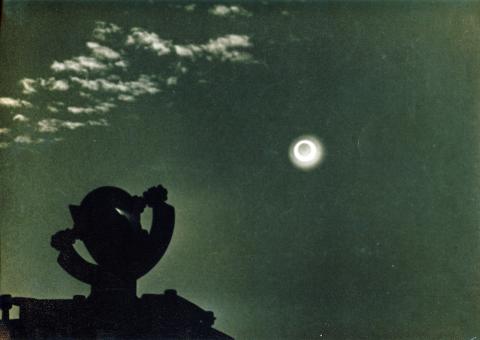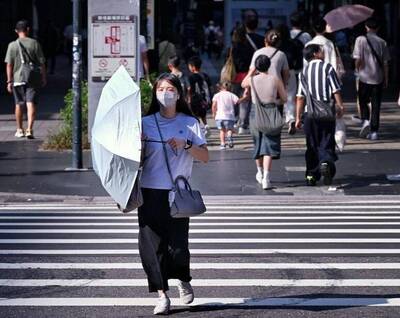Astronomy enthusiasts will be able to watch a live broadcast of an annular solar eclipse on the Web site of Central Weather Bureau, the meteorological office said yesterday.
The last time such a rare phenomenon was visible from Taiwan was on April 19, 1958.
The annular solar eclipse would not be visible again until June 21, 2020.

Photo courtesy of the Central Weather Bureau
The bureau said yesterday that the eclipse would begin in Taiwan between 6:08am and 6:10am on Monday next week and end at between 6:10am and 6:14am the same day.
The path of the annular solar eclipse will pass over residents in the northwestern part of Taiwan as well as the outlying islands of Kinmen and Matsu, who will be able to see the phenomenon clearly.
However, those living in the rest of the country will only be able to see part of the solar eclipse.
The bureau said the Dongjyu Island (東嶼) near Matsu would be the nation’s closest point to the center of the moon’s shadow. Residents of Dongjyu will be able to watch the annular eclipse for 4 minutes and 31 seconds, giving them the longest viewing window in the country.
The bureau’s observation station in Matsu also said that last time residents in Matsu saw an annular solar eclipse was on Dec. 15, 1610, when China was under the rule of the Ming Dynasty.
The station added that people in Matsu will not see the phenomenon again until Jan. 27, 2074.
Those living in Kinmen and the rest of Matsu will be able to watch the eclipse for about 4 minutes and 7 seconds and 4 minutes and 24 seconds respectively.
The bureau said the annular eclipse would last 1 minute and 37 seconds in Keelung, 1 minute and 41 seconds in Taipei, 1 minute and 38 seconds in New Taipei City (新北市), 2 minutes and 9 seconds in Taoyuan County and 1 minute 49 seconds in Hsinchu County.
Aside from the annular solar eclipse, a partial lunar eclipse will also take place on June 4, which could be seen nationwide.
The bureau said the partial lunar eclipse would begin at 6:35pm, with a missing corner first appearing on the southeast part of the moon.
The corner will gradually expand as the moon enters the earth’s shadow, and as a result about 37 percent of the moon’s surface will be covered by the Sun. The missing corner will disappear by 8:07pm and the moon will leave the earth’s shadow completely by 21:20pm.
Following the partial lunar eclipse, a transit of Venus will occur on June 6 and will be visible nationwide.
The astronomical phenomenon happens when the planet Venus passes directly between the sun and the earth.
The planetary phenomenon will occur at 6:11am, when Venus moves in from the northeast side of the sun. Observers will see a small black dot moving slowly across the sun, which will take 6 hours and 36 minutes.
The bureau said that the solar phenomenon will not occur again until Dec. 11, 2117 and advised those interested in watching the annular eclipse or Transit of Venus to watch them with special telescopes that can filter sunlight.

Three Taiwanese airlines have prohibited passengers from packing Bluetooth earbuds and their charger cases in checked luggage. EVA Air and Uni Air said that Bluetooth earbuds and charger cases are categorized as portable electronic devices, which should be switched off if they are placed in checked luggage based on international aviation safety regulations. They must not be in standby or sleep mode. However, as charging would continue when earbuds are placed in the charger cases, which would contravene international aviation regulations, their cases must be carried as hand luggage, they said. Tigerair Taiwan said that earbud charger cases are equipped

Foreign travelers entering Taiwan on a short layover via Taiwan Taoyuan International Airport are receiving NT$600 gift vouchers from yesterday, the Tourism Administration said, adding that it hopes the incentive would boost tourism consumption at the airport. The program, which allows travelers holding non-Taiwan passports who enter the country during a layover of up to 24 hours to claim a voucher, aims to promote attractions at the airport, the agency said in a statement on Friday. To participate, travelers must sign up on the campaign Web site, the agency said. They can then present their passport and boarding pass for their connecting international

Temperatures in northern Taiwan are forecast to reach as high as 30°C today, as an ongoing northeasterly seasonal wind system weakens, the Central Weather Administration (CWA) said. CWA forecaster Tseng Chao-cheng (曾昭誠) said yesterday that with the seasonal wind system weakening, warmer easterly winds would boost the temperature today. Daytime temperatures in northern Taiwan and Yilan County are expected to range from 28°C to 30°C today, up about 3°C from yesterday, Tseng said. According to the CWA, temperature highs in central and southern Taiwan could stay stable. However, the weather is expected to turn cooler starting tonight as the northeasterly wind system strengthens again

Taiwan sweltered through its hottest October on record, the Central Weather Administration (CWA) said yesterday, the latest in a string of global temperature records. The main island endured its highest average temperature since 1950, CWA forecaster Liu Pei-teng said. Temperatures the world over have soared in recent years as human-induced climate change contributes to ever more erratic weather patterns. Taiwan’s average temperature was 27.381°C as of Thursday, Liu said. Liu said the average could slip 0.1°C by the end of yesterday, but it would still be higher than the previous record of 27.009°C in 2016. "The temperature only started lowering around Oct. 18 or 19